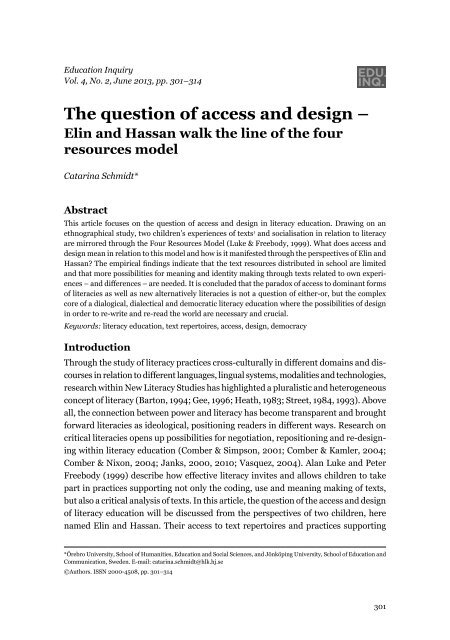Download issue - Umeå universitet
Download issue - Umeå universitet
Download issue - Umeå universitet
You also want an ePaper? Increase the reach of your titles
YUMPU automatically turns print PDFs into web optimized ePapers that Google loves.
Education Inquiry<br />
Vol. 4, No. 2, June 2013, pp. 301–314<br />
EDU.<br />
INQ.<br />
The question of access and design –<br />
Elin and Hassan walk the line of the four<br />
resources model<br />
Catarina Schmidt*<br />
Abstract<br />
This article focuses on the question of access and design in literacy education. Drawing on an<br />
ethnographical study, two children’s experiences of texts 1 and socialisation in relation to literacy<br />
are mirrored through the Four Resources Model (Luke & Freebody, 1999). What does access and<br />
design mean in relation to this model and how is it manifested through the perspectives of Elin and<br />
Hassan? The empirical findings indicate that the text resources distributed in school are limited<br />
and that more possibilities for meaning and identity making through texts related to own experiences<br />
– and differences – are needed. It is concluded that the paradox of access to dominant forms<br />
of literacies as well as new alternatively literacies is not a question of either-or, but the complex<br />
core of a dialogical, dialectical and democratic literacy education where the possibilities of design<br />
in order to re-write and re-read the world are necessary and crucial.<br />
Keywords: literacy education, text repertoires, access, design, democracy<br />
Introduction<br />
Through the study of literacy practices cross-culturally in different domains and discourses<br />
in relation to different languages, lingual systems, modalities and technologies,<br />
research within New Literacy Studies has highlighted a pluralistic and heterogeneous<br />
concept of literacy (Barton, 1994; Gee, 1996; Heath, 1983; Street, 1984, 1993). Above<br />
all, the connection between power and literacy has become transparent and brought<br />
forward literacies as ideological, positioning readers in different ways. Research on<br />
critical literacies opens up possibilities for negotiation, repositioning and re-designing<br />
within literacy education (Comber & Simpson, 2001; Comber & Kamler, 2004;<br />
Comber & Nixon, 2004; Janks, 2000, 2010; Vasquez, 2004). Alan Luke and Peter<br />
Freebody (1999) describe how effective literacy invites and allows children to take<br />
part in practices supporting not only the coding, use and meaning making of texts,<br />
but also a critical analysis of texts. In this article, the question of the access and design<br />
of literacy education will be discussed from the perspectives of two children, here<br />
named Elin and Hassan. Their access to text repertoires and practices supporting<br />
*Örebro University, School of Humanities, Education and Social Sciences, and Jönköping University, School of Education and<br />
Communication, Sweden. E-mail: catarina.schmidt@hlk.hj.se<br />
©Authors. ISSN 2000-4508, pp. 301–314<br />
301

















